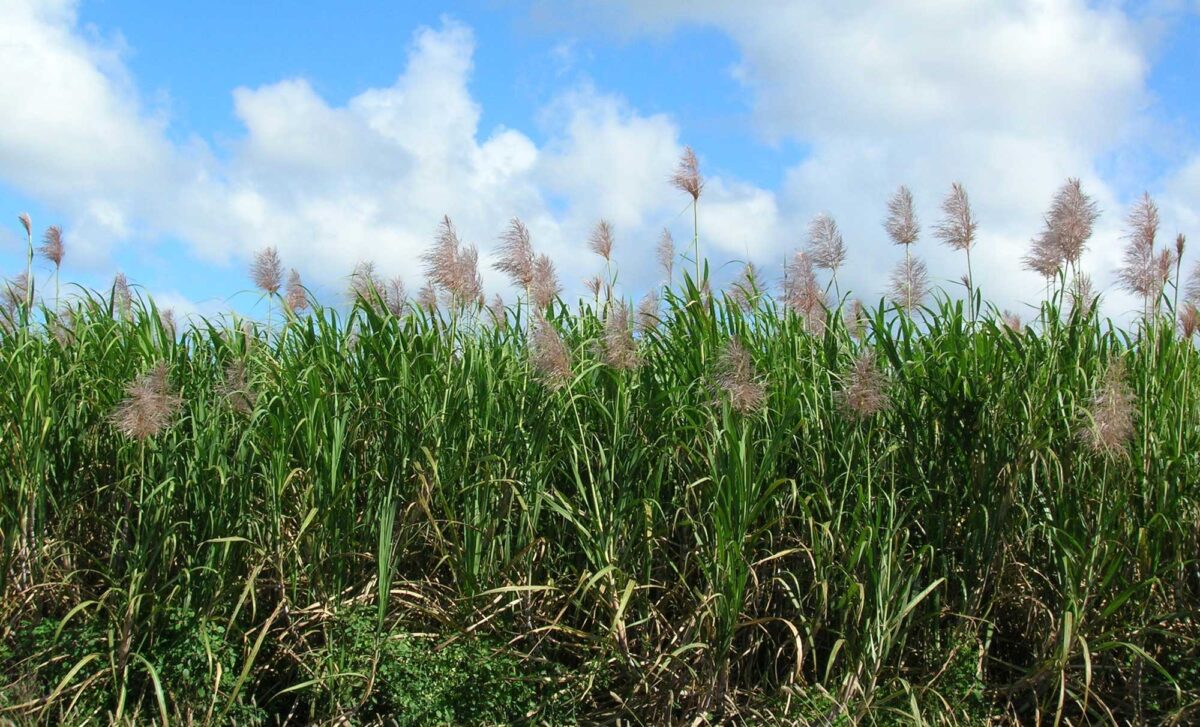Page snapshot: Introduction to the structure of the sugarcane plant, including the morphology (form) and anatomy (internal structure) of stems and leaves. Also covers the organization of the reproductive structures.
Topics covered on this page: Introduction; Stems; Leaves; Reproductive structures; Inflorescences, spikelets, and florets; Fruits; Resources.
Credits: Funded by the National Science Foundation. Any opinions, findings, and conclusions or recommendations expressed in this material are those of the author(s) and do not necessarily reflect the views of the National Science Foundation. Page by Elizabeth J. Hermsen (2023).
Updates: Page last updated January 30, 2023.
Image above: A field of sugarcane (Saccharum officinarum). Photo of Forest and Kim Starr (Image number: 5416923, Invasive.org, Creative Commons Attribution 3.0 United States license, image cropped and resized).
Introduction
The purpose of this page is to introduce the basic structure of sugarcane plants (Saccharum species) with a focus on domesticated sugarcane (Saccharum officinarum) and its hybrids, as well as its close relatives robust sugarcane (Saccharum robustum) and wild sugarcane (Saccharum spontaneum).
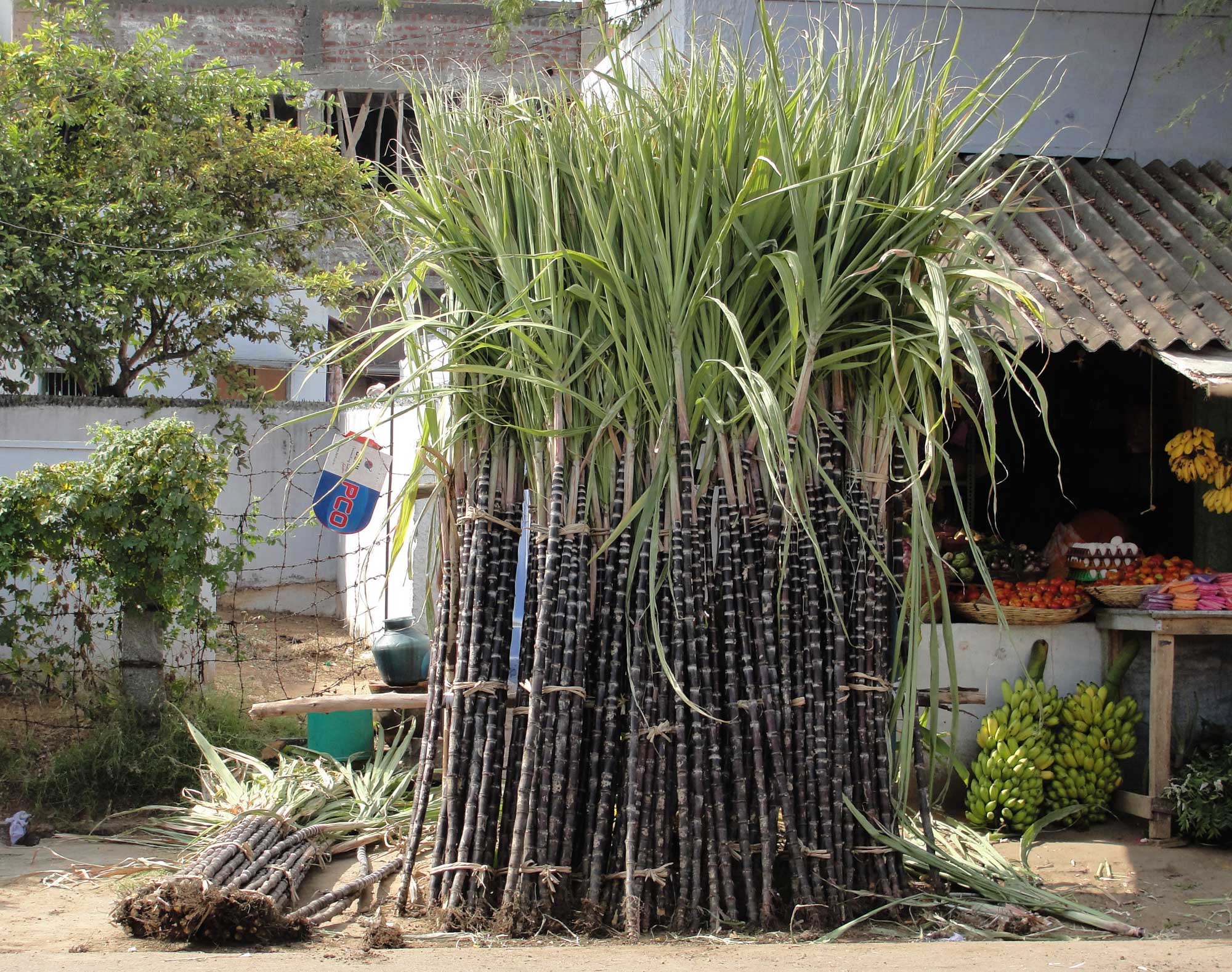
Bundles of sugarcane that have been harvested standing near a food stall. Photo by Thamizhpparithi Maari (Wikimedia Commons, Creative Commons Attribution-ShareAlike 3.0 Unported license, image cropped and resized).
Stems
Cultivated sugarcane has a single thick stalk or culm that ends in an inflorescence. The culms can be up to 19.5 feet (6 meters) tall! Unlike in many other grasses, the interior of a sugarcane stem is solid in both nodal and internodal regions. In this way, it resembles the stem of maize (Zea mays) and sorghum (Sorghum bicolor), two other domesticated plants in Tribe Andropogoneae.
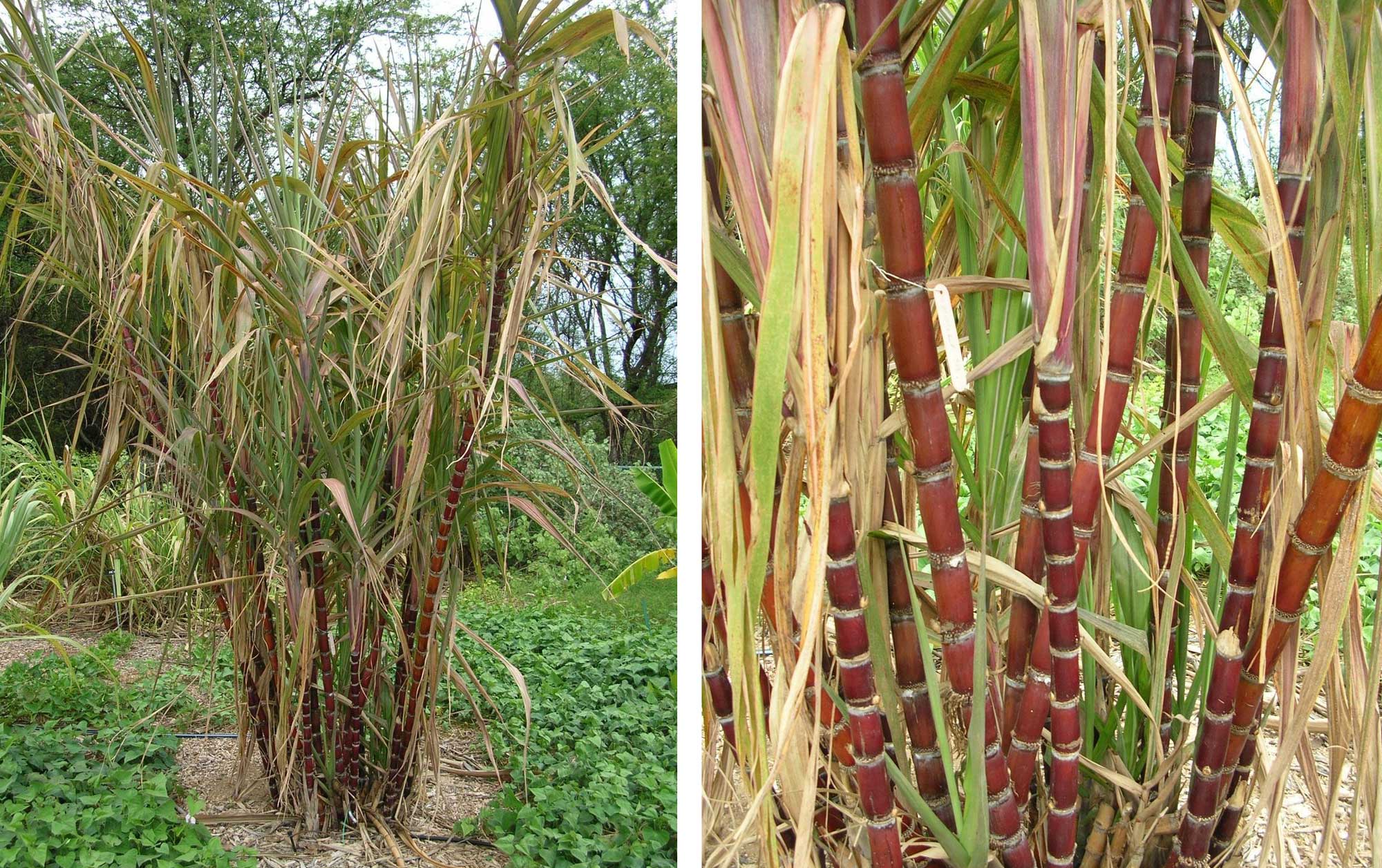
Sugarcane plants (Saccharum officinarum) and detail of stems (culms). Note the clear nodal (light bands) and internodal (reddish regions) of the stem. Photos by Forest and Kim Starr, Starr Environmental (Image numbers 5412630 and 5412631, Invasive.org, Creative Commons Attribution 3.0 United States license, images cropped and resized).
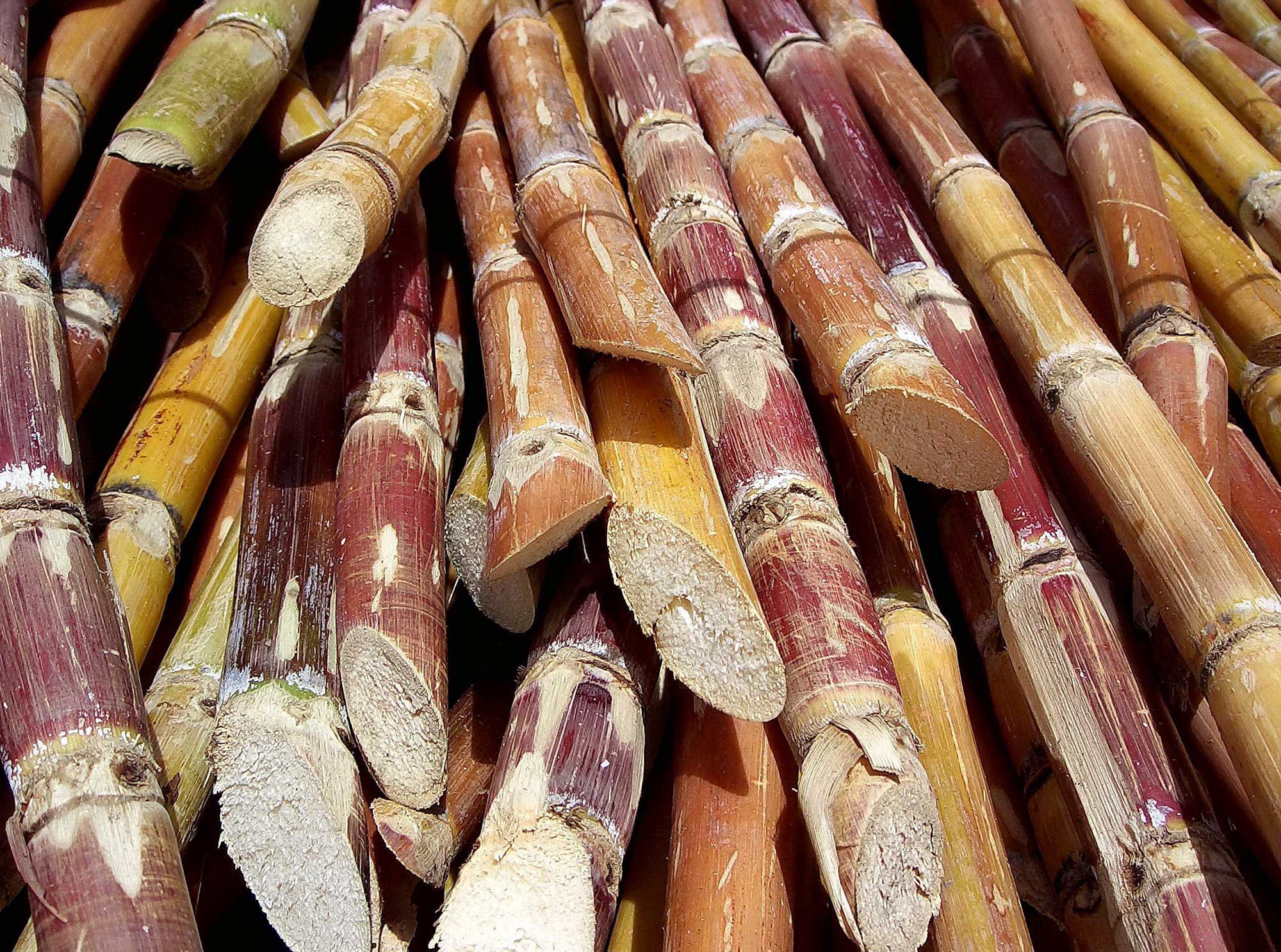
Sugarcane (Saccharum) culms (stems) that have been cut, showing the solid central region. Photo by ruurmo (flickr, Creative Commons Attribution 2.0 Generic license, image resized).
Leaves
Sugarcane leaves are organized like the leaves of other grasses. Each leaf consists of a sheath that wraps around the stem and an elongated blade that sticks out from the side of the stem and intercepts sunlight. The major leaf veins are parallel. The ligule is membrane-like with a fringe of hairs.
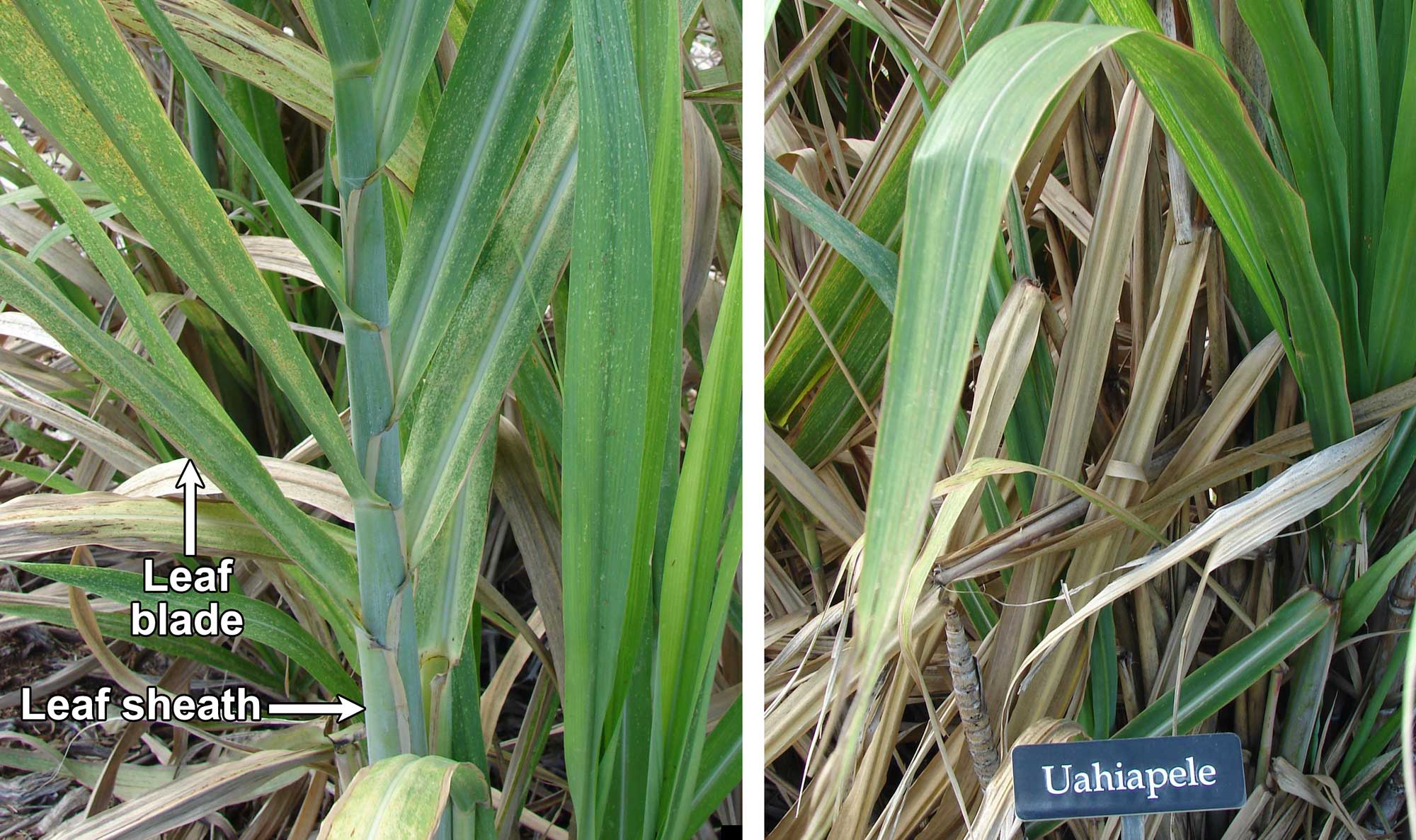
Sugarcane (Saccharum officinarum) foliage leaves. Left: Detail of leaves attached alternately (one at a time) to a stem, showing sheaths and blades. Right: A leaf blade. Photos by Forest and Kim Starr, Starr Environmental (Image numbers 5420239 and 5420237, Invasive.org, Creative Commons Attribution 3.0 United States license, images cropped and resized).
Reproductive structures
Inflorescences, spikelets, and florets
Sugarcane inflorescences are featherlike panicles. A panicle is an inflorescence with a central stem and lateral (side) branches. The lateral branches bear rames (delicate, spikelet-bearing branches that break apart when mature), and each rame has many pairs of spikelets.
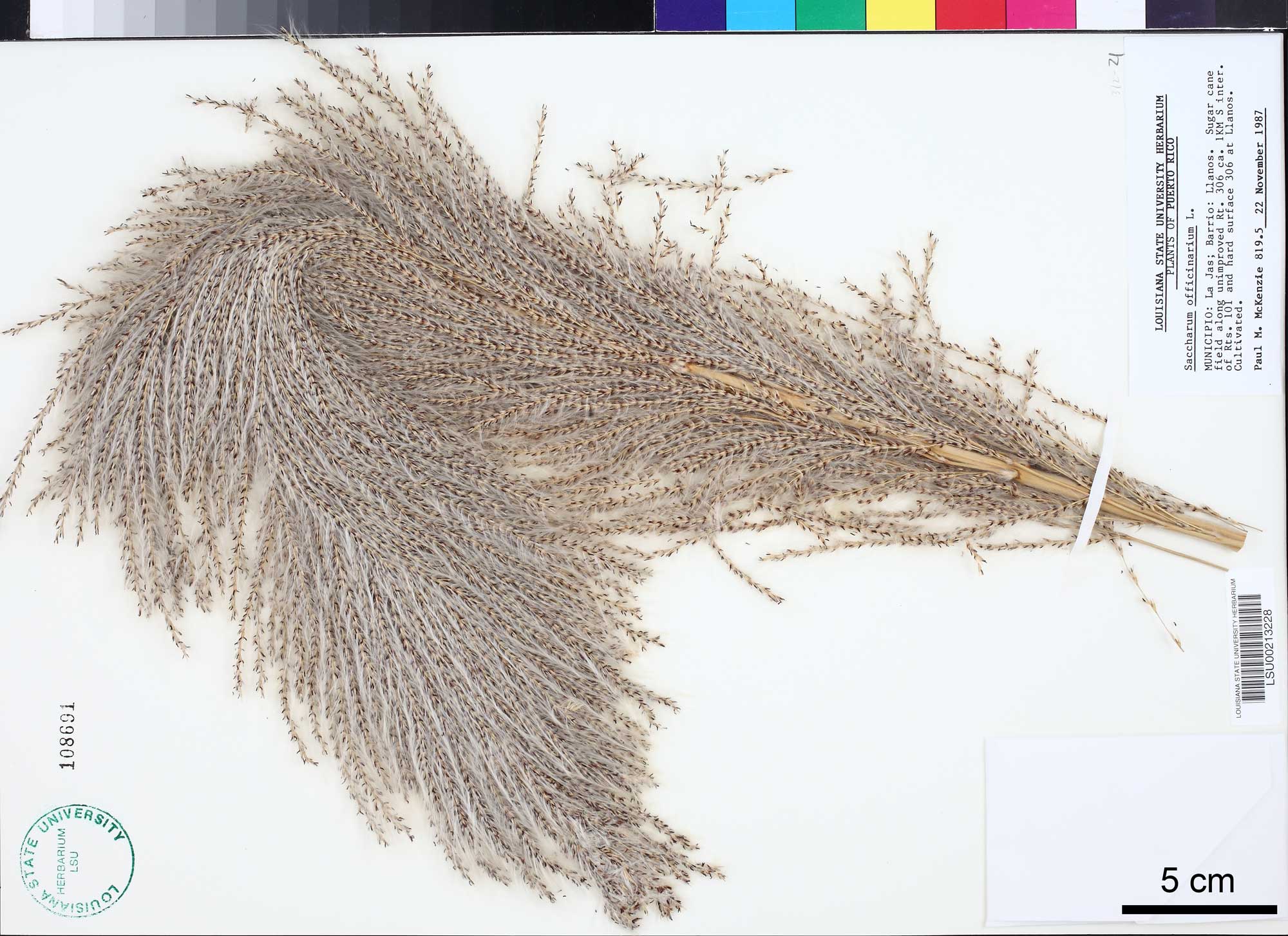
Inflorescence of sugarcane (Saccharum officinarum) showing feather-like structure. Herbarium sheet, specimen collected in Puerto Rico by Louisiana State University, Shirley C. Tucker Herbarium (LSU-Vascular Plants) (image via GBIF.org, Creative Commons Attribution-NonCommercial 3.0 Unported license, image cropped, resized, and labeled).
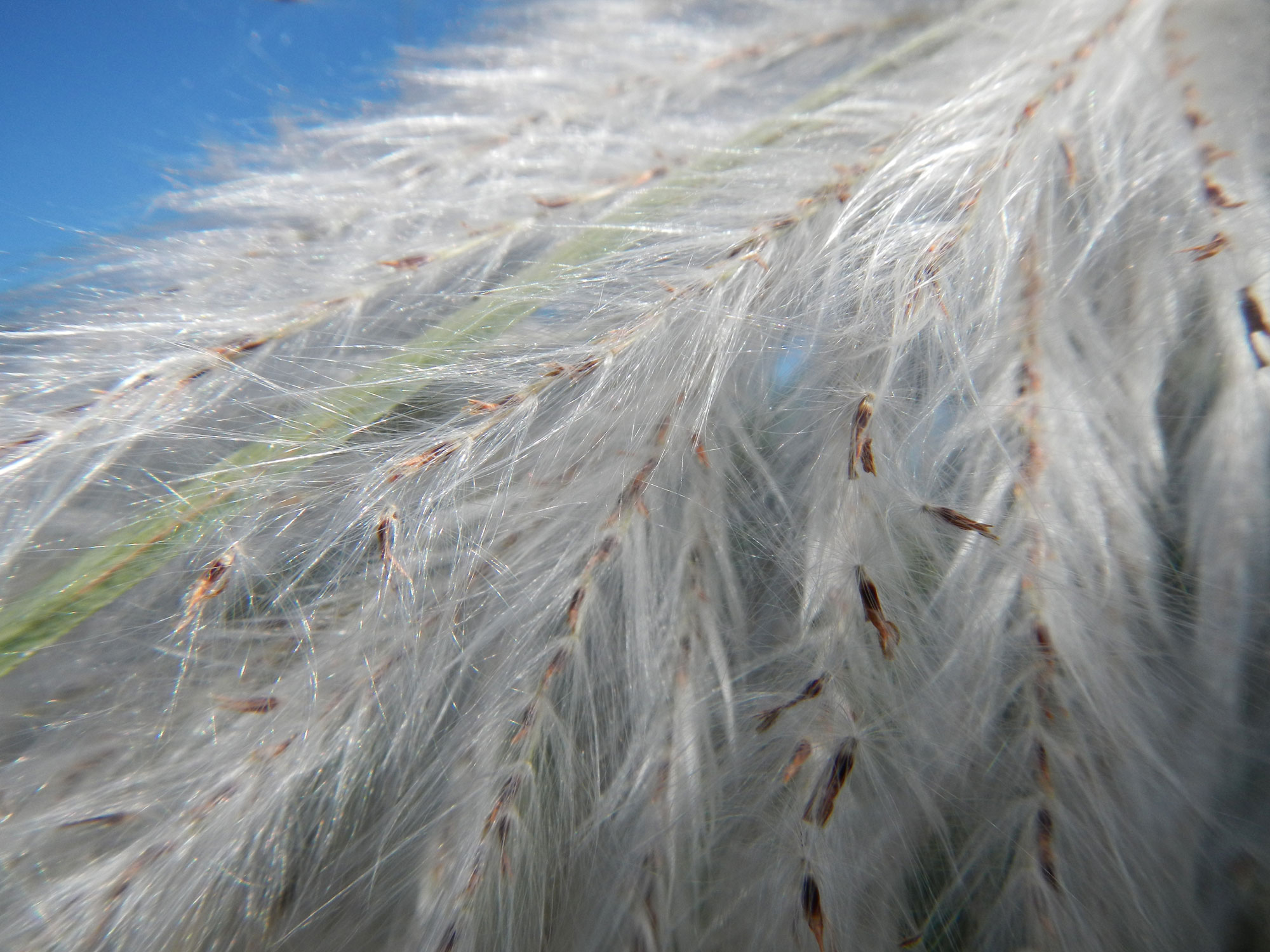
Detail of the inflorescence of wild sugarcane (Saccharum spontaneum) showing rames and feathery hairs. Photo by Judgefloro (Wikimedia Commons, Creative Commons Attribution-ShareAlike 4.0 International license, image resized).
The spikelets in sugarcane are mostly in pairs, although the spikelets at the ends of branches are in groups of three. Each spikelet pair includes one pedicellate (stalked) spikelet and one sessile (stalkless) spikelet; groups of three spikelets have one sessile and two pedicellate spikelets. Each spikelet has one fertile floret. The fertile floret is bisexual, meaning that it has both stamens (male or pollen-producing structures) and a pistil (female or ovule-producing structure).
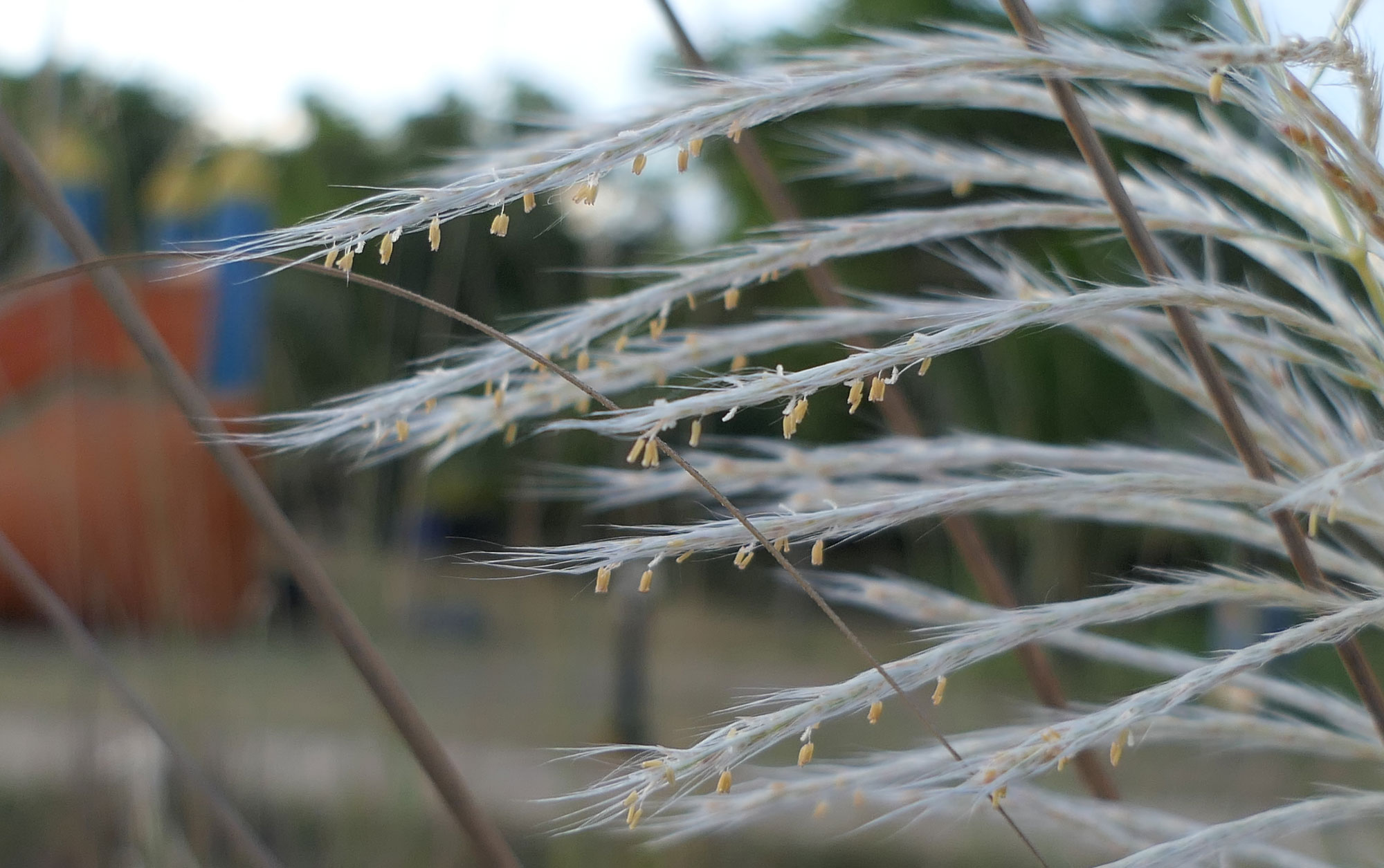
Anthers dangling from the spikelets of wild sugarcane (Saccharum spontaneum). Photo by Dinesh Valke (Wikimedia Commons, Creative Commons Attribution-ShareAlike 2.0 Generic license, image cropped and resized).
Fruits
Following pollination and fertilization, the fertile florets mature into fruits. Sugarcane fruits are grains or caryopses. Inflorescences of sugarcane disarticulate (break apart) when they are mature. They break in two places: The pedicellate spikelets break away from the tips of their pedicels, and the rame axes (the small branches that bear the spikelets) break apart under each of the sessile spikelets. Thus, the sessile spikelets are dispersed with two short stalks attached: the pedicel from the pedicellate spikelet and a portion of the rame axis (branch).

Disseminules (dispersal units) of wild sugarcane (Saccharum spontaneum). Each disseminule pictured here consists of a mature sessile spikelet (caryopsis and surrounding bracts) and two attached stalks (the pedicel from the pedicellate spikelet and a portion of the rame axis). Photo by Julia Scher, Federal Noxious Weeds Disseminules, USDA APHIS PPQ (Image number 5376777, Invasive.org, Creative Commons Attribution-NonCommercial 3.0 United States license, image cropped, resized, and labeled).
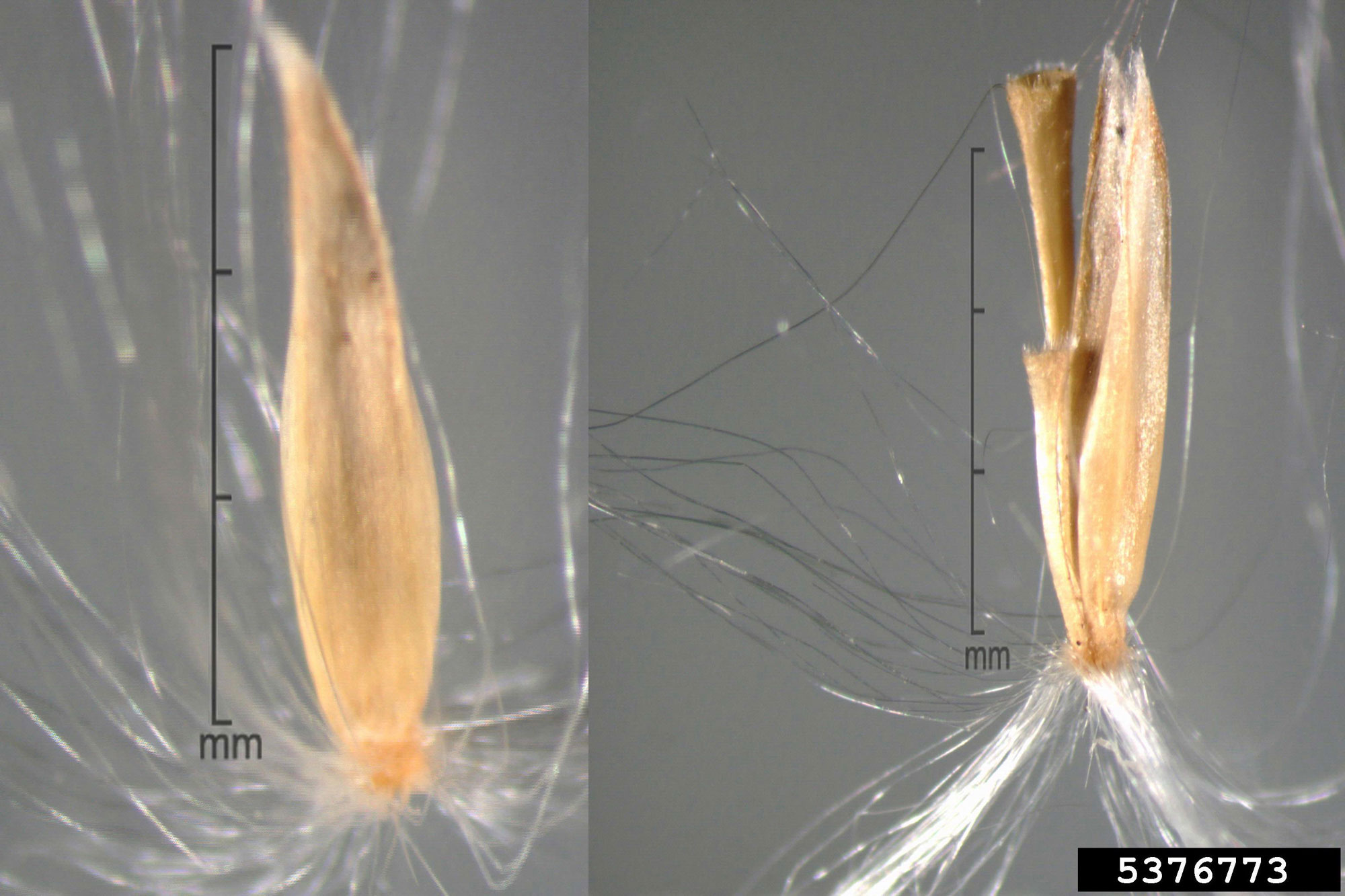
Disseminule of sugarcane (Saccharum officinarum) with rame axis and pedicel attached to a mature sessile spikelet. Photo by Julia Scher, Federal Noxious Weeds Disseminules, USDA APHIS PPQ (Image number 5376773, Invasive.org, Creative Commons Attribution-NonCommercial 3.0 United States license, image cropped, resized, and labeled).
A sugarcane caryopsis (fruit) consists of a sugarcane embryo and endosperm surrounded by a pericarp (fruit wall).
The sugarcane embryo, like grass embryos generally, is complex. The upper end of the embryo is covered by a coleoptile, or protective sheath. The radicle (embryonic root) at the opposite end of the embryo, is also protected by a sheath, the coleorhiza. A cotyledon (seed leaf) called a scutellum is attached to the embryo between the plumule and the radicle. The outer layer of the endosperm is the aleurone layer.
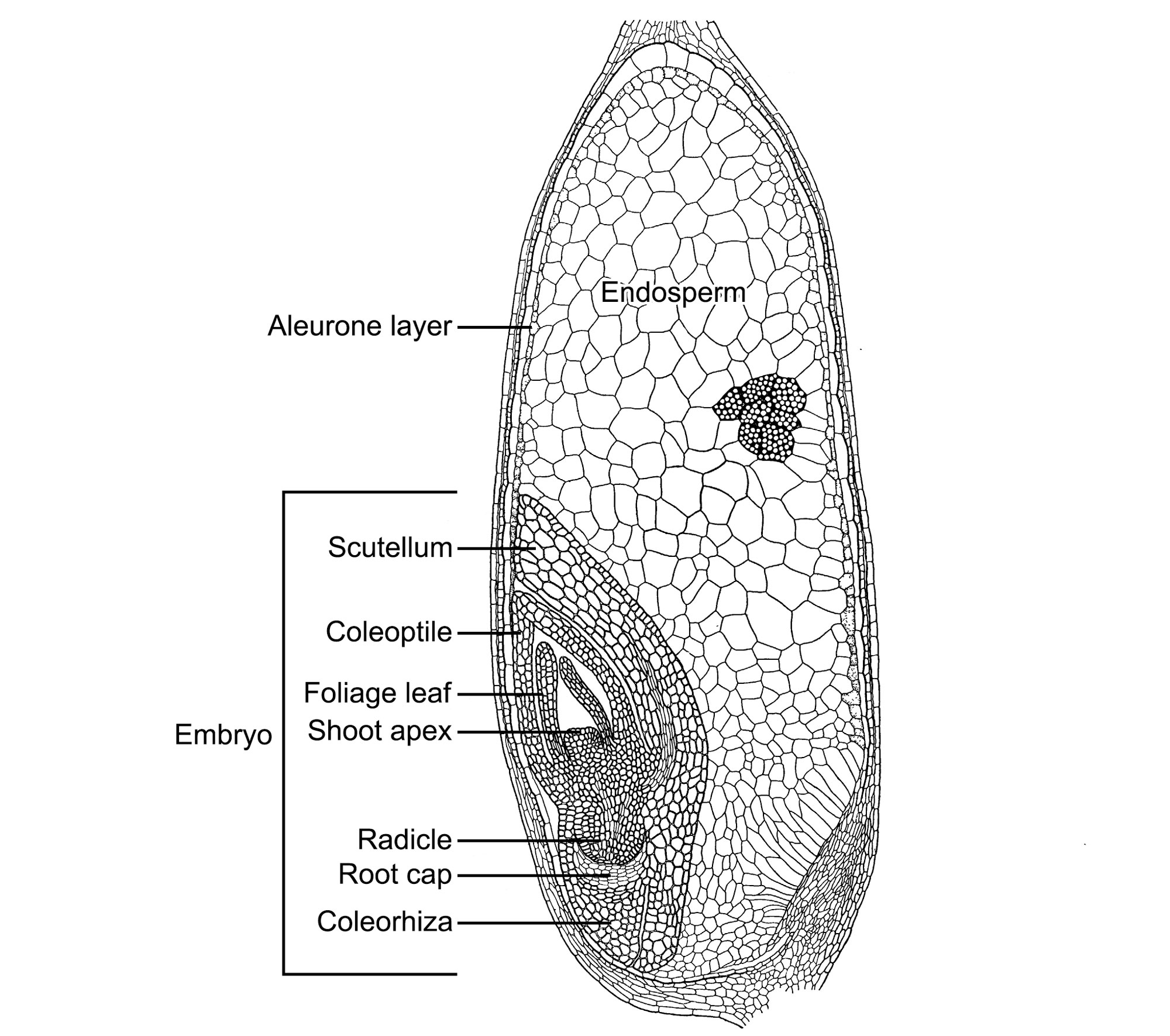
Longitudinal section of a sugarcane caryopsis showing the embryo and endosperm. Source: Modified from figure 16 in Artschwager et al. (1929) Journal of Agricultural Research 39: 1-30 (via USDA National Agricultural Library Digital Collections).
Resources
Websites
Glossary of botanical terms used in Poaceae (Flora of China online): http://flora.huh.harvard.edu/floradata/002/vol22/poaceaeglossary.htm
Poaceae (Graminae) (University of Hawai'i): http://www.botany.hawaii.edu/faculty/carr/po.htm
Scientific articles and books
Artschwager, E., E. W. Brandes, and R. C. Starrett. 1929. Development of flower and seed of some varieties of sugar cane. Journal of Agricultural Research 39: 1-30. https://handle.nal.usda.gov/10113/IND43967678
Clark, L. G., and E. A. Kellogg. In Flora of North America Editorial Committee, Flora of North America North of Mexico vol. 24. Poaceae. Accessed online at: http://floranorthamerica.org/Poaceae
Kellogg, E. A. 2015. Flowering Plants, Monocots, Poaceae. The Families and Genera of Vascular Plants 13, 416 pp. (K. Kubitzki, ed.). Springer International Publishing, Switzerland. https://doi.org/10.1007/978-3-319-15332-2_1



